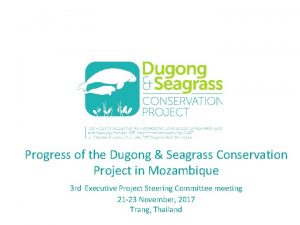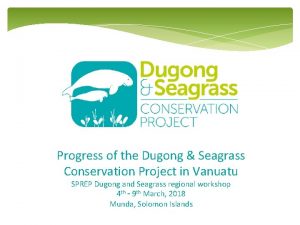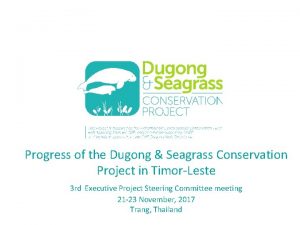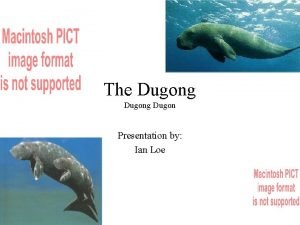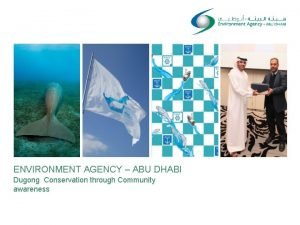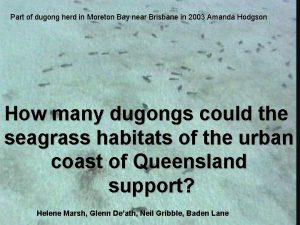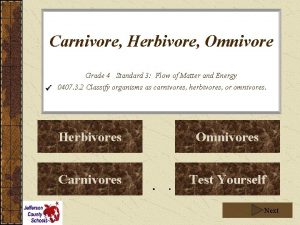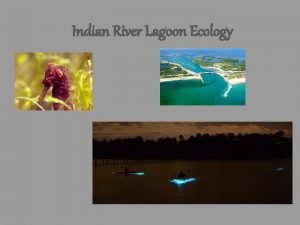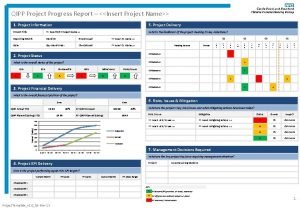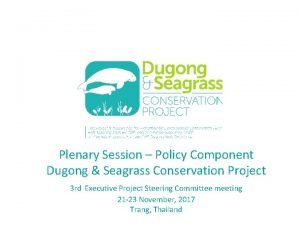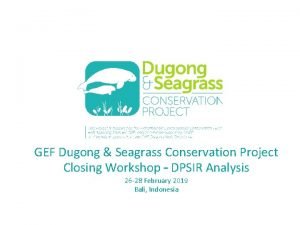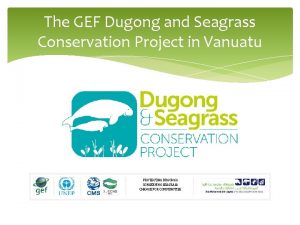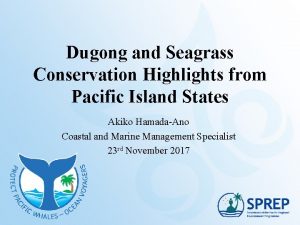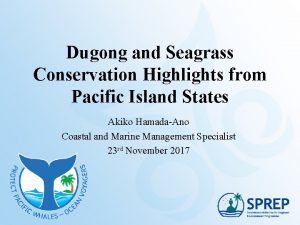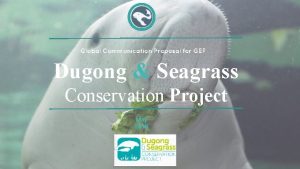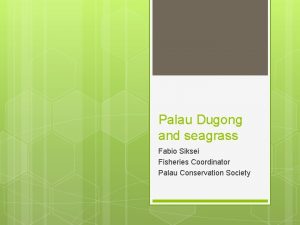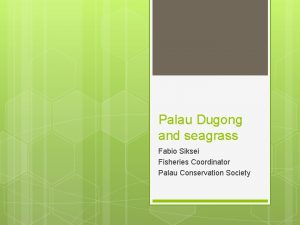Progress of the Dugong Seagrass Conservation Project in













- Slides: 13

Progress of the Dugong & Seagrass Conservation Project in Madagascar Third Executive Project Steering Committee meeting 21 -23 November, 2017 Trang, Thailand

Past, present and future of dugong and seagrass conservation in Madagascar Baseline in 2015 Progress by 2017 Targets for 2018 • Limited information on dugong and seagrass; • No priority sites identified yet • First consultation of community and NGO in the Northwest at MIHARI regional fora • Community-based monitoring/ management structures exists but not integrating dugongs • Policies: Dugong Mo. U signed in 2010 but only one sectorial policy integrates dugongs and seagrass • Availability of data base and continuous data collection • Dugong and seagrass hotspots and priority areas identified and mapped • Greater awareness and discussion on Dugong and seagrass from community fishers and re-definition of conservation measures: Dina; Ramsar extra layer; MPA management plan updates; conservation targets, incentives • Education on seagrass and Dugong importance at the national and local level through forums and national events; • New private sector and NGO partners involved and new sites supported • A better community awareness and management of seagrass and Dugong • Development of educational tools and outreach (Dugong festival) • Extend conservation measures at local and national Centralization of dugong and seagrass database • Communication of research results: participatory mapping. • Policy gap analysis and Dugong and seagrass conservation strategy development

Results from dugong research • • • Dugong research questions addressed by the Project in your country – status assessment of dugong in the Nosy Hara National park, – identification of hotspot for dugongs, identification of infractions on dugongs and other marine species and habitats Methods applied by Project in your country to answer the research questions – Monthly survey sheet on dugong sighting and infractions /dugong questionnaires (CMS) – Passive acoustic monitoring using Soundtrap recorders Sites of the research area for dugongs: North-West (Nosy Be and Analalava areas, Sahamalaza and Nosy Hara parks) Status of dugong population in the research area: No dugong mortalities since 2015 either accidental or deliberate. Live sightings continue especially of mother and calf pairs in Nosy Hara Number of sightings of dugongs since 2015: none in Nosy Be area; 4 in Mahajanga area, 11 in Sahamalaza project area. Top 3 threats to dugongs and follow up actions by the Project to address them: – Bycatch with jarifa gillnets -> define conservation measures with local communities, integrate in dina (setting of nets away from shallow seagrass beds and instructions on release of by-caught animals) – opportunistic hunting -> awareness raising on dugong conservation – Habitat loss – awareness raising on the importance of marine ecosystems as seagrass beds; monitor key seagrass areas key dugong research results from the Project: database on dugong sighting, hotspots, habitat, NW Seagrass maps, acoustic data from Nosy Be and Mahajanga areas Research work to be carried out by the Project until 2018 and key research deliverables – Status of dugong in the Nosy hara park, all hotspots confirmed for recommendation as high protection zones by communities and Madagascar National Parks – Acoustic monitoring in Mahajanga area -> Dugong occurrence in the area Dugong research needs that have not been addressed by the Project so far : population size estimation due to scarcity of the animal across vast areas

Results from seagrass research • • 2 seagrass research questions addressed by the Project in Madagascar: – What is the species composition and distribution of seagrass beds in the Park? Are they healthy? – -Seagrass hotspots identified as high, low or zero probability of seagrass Methods applied by the Project: – Seagrass Watch – Mapping using spectral analysis of 30 -meter resolution Landsat 8 satellite imagery Number of sites and total size in hectares of the research area for seagrass – 4 sites (size not estimated yet) in Nosy Hara park – A total of 28, 000 km 2 in NW (Mahajanga and Nosy be areas) Status of seagrass habitats in the research area in 2015 and today: Healthy with 8 species recorded, last monitoring March-April 2016 Top 3 threats to seagrass : Run off from land, climate change (bleaching, cyclone damage); destructive fishing gears e. g beach seine Most important research results from the Project: Seagrass bed maps of NW, seagrass health state Who/ how hosts the data on seagrass in your country and how, with whom has been seagrass data shared : At each Project partner, and sharing among project partner during quarterly meeting Research work to be carried out by the Project until 2018 and key research deliverables – Participatory mapping and seagrass monitoring – Community-based monitoring of seagrass

Project policy response to dugong & seagrass conservation needs in Madagascar • • The most important policy needs of dugong & seagrass conservation identified in 2015: – Need of integrating seagrass and dugong conservation in community’s Dina. – inclusion of significant areas of seagrass beds within specific legislation pertaining to seagrass and dugong protection Key policy gaps to effective dugong & seagrass conservation identified by 2017: effective regulations/policies covering dugong and seagrass conservation 3 key results achieved by the Project by 2017 to address the identified policy needs and gaps : – Policy gap analysis under process: To. Rs being finalized to recruit consultant – Adoption of 3 motions (ideas raised by communities at MIHARI National forum 2017 and presented to the Government of Madagascar: recognition and empowerment of Dina, Fishing gears regulation, Exclusive fishing zone for small-scale fishers How information generated by the Project has been used to inform decision-making: Establishment of Dugong Steering Committee lead by Focal Point of Dugong, MS Focal Point How sustainability of the National Facilitating Committee developed under the Project will be ensured after the end of the project: Decree appointing National Facilitating Committee and elaboration of national strategy for the conservation of Dugong and Seagrass Policy work under the Project until 2018, listing key policy-related deliverables: – Gap analysis on legislation related to conservation of Dugong and Seagrass, – List of recommendations and conservation measures related to. 2 policy needs of dugong/ seagrass conservation that have not been addressed by the Project in your country, so far: National legislation/policy review so that specific laws pertain to dugongs and seagrass and synergy/inclusion in existing LMMA/MPA guidelines

Community-based stewardship of dugongs and their seagrass habitats (1) • • • Number of Project sites of community work in your country identified in 2015: Five sites (Barren Isles, Ankarea and Ankivonjy MPAs, Sahamalaza and Nosy Hara parks) Type of existing community based management and monitoring structures: Dina, Monitoring and Surveillance Committee Number of the sites by 2017: 5 extra priority sites for MIHARI, two sites localized in Sahamalaza park confirmed to be dugong hotspots 2 most common threats within the Project sites that the Project is trying to address : Very low awareness of Dugong and seagrass importance ; Dugong hunt and by-catch 2 most common community needs that dugong and seagrass conservation has to address in the selected sites: – Awareness raising and Community empowerment through local management – More alternative livelihoods 3 key results from the Project that address the most common threats and community needs : – Creation of MPA where trawling and the use of destructive fishing gears are banned, – Development of a Dina for the MPA that includes permanent and temporary reserves – Development of a Monitoring, Surveillance and Control program co-led by the fishing communities Type of community-based management structures strengthened by the Project: – Community association managing or co-managing MPA/LMMA; – Creation of a structure for MIHARI with a national board leaded by a President of LMMA Type of community-based monitoring structures strengthened by the Project: MCS program; Joint patrolling Estimated share of women involved in management/ monitoring of the project sites: between 10 and 20% of management steering committee members Perspective for the sustainability of community-based monitoring and management structures in the long-term : build foundation for long-term sustainability through highly consultative process and creating community ownership of the MPA/LMMA, Community control and Surveillance members are volunteers motivated by the positive impacts of control on fishery catch

Community-based stewardship of dugongs and their seagrass habitats (2) • • • Types of incentive models: Apiculture, Access to health service, handicrafts, farming Link of the incentives to dugongs and seagrasses: – Reduce fishing effort and dependence to natural resource – Better engagement in natural resource management. Number of community members participating in incentives models: 08 Community health workers, among which 04 women are supervised and trained to provide basic child and maternal care and sexual and reproductive health services in Barren Isles MPA. Ensuring and monitoring the sustainability of the incentives: Providing access to health is designed to use community health workers and key health partners to ensure sustainable in long-term. Community-related work of the Dugong and Seagrass Conservation Project until 2018 : – Participatory assessment and mapping of the seagrass areas for the Barren Isles MPA – Community leaders that benefited the participatory mapping training in February 2017 will train their community – Supporting community on elaborating/ amending their Dina to include the conservation of Dugongs and seagrass 2 community-related needs of dugong/ seagrass conservation that have not been addressed by the Project : – Ongoing protection of the Barren Isles MPA from industrial trawlers which could be reopened to negotiation. – Exchange visits between community involved with the Dugong projects

Education & Awareness about dugongs and seagrass • • 3 Key target audiences and needs of education and awareness under the Dugong and Seagrass Conservation Project : local community ; Fishermen and local and Regional authorities 3 most influential results from education: – – – • Effectiveness and sustainability of education & awareness activities: – – – • Target audiences benefited from awareness raising sessions on the importance of seagrass and their related fauna conducted during participatory assessment and mapping missions of seagrass. Most of the people who attended MIHARI fora and Dugong and seagrass education awareness do not see Dugongs anymore as tasty as pork. The authorities from 3 regions in the Northwest attended an education and awareness activity organized in Nosy Hara and now aware of the status and threats of Dugong and seagrass Awareness tools produced (Teacher training Manual & Toolkit, Dugong storybooks, brochures, infoboards installed, factsheet, Dugong t-shirts). More than 90% of community members know about dugongs and their importance. Other GEF projects replicated MIHARI’s materials Teacher trained on Environmental guide in the school surrounding Nosy Hara marine park. 117 Junior Ecoguard trained in the Park but a further 1200 outside the Park and 40 Conservations ambassadors among Junior Ecoguard network of the North region trained on Conservation of Dugong and seagrass Education and awareness work of the Dugong and Seagrass Conservation Project until 2018 and 2 key deliverables – – 1 training/outreach event every two months disseminating information on dugongs, seagrass and interactions with fisheries (sketch and song on Dugong and seagrass conservation), Component in Teacher Training Manual for schools nationwide, endorsed by the Ministry of Education.

Project indicator Year 2015 Year 2017 1. Total area of seagrass (key areas for dugongs) under improved conservation management 571, 941 ha (direct+indirect) 4 regional sites (2 sites, IUCN, cat. II) 1, 001, 941 ha (13 seagrass sites) 5 regional sites 2. METT scores in targeted protected areas (MPAs, LMMAs, others) in national programmes Total: 152 Average: 38 Total: 200 Average: 38 3. Use of gill nets (beach seines), fixed fish traps and other damaging methods) by fishermen (which result in incidental dugong mortality) reduced Information exists but without specific data on “bad” fishing gear/ methods Dugong Mo. U questionnaire carried out in 2 regional sites - No incidents reported Ban on bottom trawling and use of bad fishing gears through local conventions (Dina) 4. Community engagement in community engagement exists in management (CBM) for dugong 4 sites but not around dugong and conservation in selected priority seagrass conservation target areas (LMMAs, other seagrass protection zones, co-management of MPAs) 50 communities from 5 regional sites engaged in management of resources, including dugong conservation Management plans for 2 sites developed Data on seagrass and dugongs integrated in the management of 5 PAs/ LMMAs 5. Number of community-based conservation/ monitoring systems established and functioning for dugong and seagrass) in priority target areas 19 committees representation in 2 MPAs; 40 local governance structures established in 2 national parks and monitoring protocols developed; Community-led Monitoring Control and Surveillance system to combat illegal fishing in 2 regional sites. Trainings and forums for local community members in seagrass mapping, dugong monitoring and marine resource management, patrolling Some community-based conservation systems exist in 4 regional sites but not related to dugongs and seagrass

Project indicator Year 2015 Year 2017 6. Number and uptake of incentive mechanisms (ie. market-based, social, cultural, religious) and management tools linking sustainable fishing practices and adoption of best practice (see also Indicator 3) Community-based sustainable fisheries exist in 1 or 2 regional sites No information on women participation 3 types of economic incentives hospitality (tourism and restaurants), arts (handicrafts) and farming (livestock and chicken breeding, apiculture) 3 types of social benefits: health services in 3 regional sites, school facilities and water reservoirs. All this conditional on: stopping of “bad” fishing methods and gear use 7. Availability and uptake of conservation management information (digital maps of dugong and seagrass distribution & status; ecosystem services valuation data; pilot studies – e. g. assessment of Blue Carbon potential) No dugong and seagrass data Seagrass beds of Northwest Madagascar mapped and status assessed MIHARI database for 5 sites Maps and data of dugong seagrass across 6, 465 ha Passive Acoustic survey of dugongs +3000 local people reached through awareness raising campaigns (+1000 Dugong festival), school programmes and trainings; children’s book “Lala the dugong” 1 study on carbon sequestration capacity of seagrasses in Northwest Madagascar 8. Progress on implementation of national and regional Strategies/ Action Plans for dugong and seagrass conservation No Dugong National Plan of Actions Regional Fisheries Management plans in Barren Isles and NW 9. Incorporation of dugong protection and dugong/ seagrass conservation in other sectors (e. g. fisheries, coastal zone management & regulations) No policy gap analysis Proposal for exclusive fishing zone for small-scale fishers

Madagascar lessons learned q What went well and why? Ø We have found it more effective to have an integrated approach in terms of awareness raising, focusing on connected habitats, such as coral reef and seagrass, and related fauna, rather than focusing only on dugongs and seagrass. Ø Working closely with other national private sector and NGO partners helped to extend project impacts as well as to learn from teach partner’s experiences. It helped to know also partners’ needs and which a national network like MIHARI can fulfill Ø The involvement of local communities is key for the conservation of marine resources including dugongs and seagrass q § § § What went wrong and why? Acoustic recorders getting lost or damaged : ropes and buoys got stolen Effectiveness of Dina without support from Park managers and local authorities Lack of of data and knowledge on Dugong population monitoring and conservation make decision makers reluctant to get more involved in the project q How can we do better? ü Use of appropriate technology : providing fishermen with simple sturdy cameras, training them in dugong survey ü For LMMA, focus on proven dugong hotspots only, not general marine management outcomes

Next steps • • • Operationalization of conservation measures: community-led MCS program, Dina and updated management plan Implementation of the temporary and permanent reserves within MPA. Education and awareness: Elaboration of education materials: comic on seagrass and a facilitating guide that can be used by the national partners in their sites; extending outreach on dugong and seagrass conservation Organization of a Dugong Festival Organization of the seagrass watch training for community and project partners Share research findings with regional and national stakeholders Plan for conservation and management of dugong and seagrass outside of Marine Park Kick off Policy gap analysis Elaborate dugong and seagrass management national strategy

 Dugong and seagrass conservation project
Dugong and seagrass conservation project Dugong and seagrass conservation project
Dugong and seagrass conservation project Dugong
Dugong Physical progress and financial progress
Physical progress and financial progress Dugong food chain
Dugong food chain Dugongs in uae
Dugongs in uae Moreton bay dugong
Moreton bay dugong Omnivore examples
Omnivore examples Slide and are carnivores
Slide and are carnivores White mangrove
White mangrove How to report project progress
How to report project progress Measuring project progress
Measuring project progress Engineering final year project presentation sample
Engineering final year project presentation sample Status progress report
Status progress report
